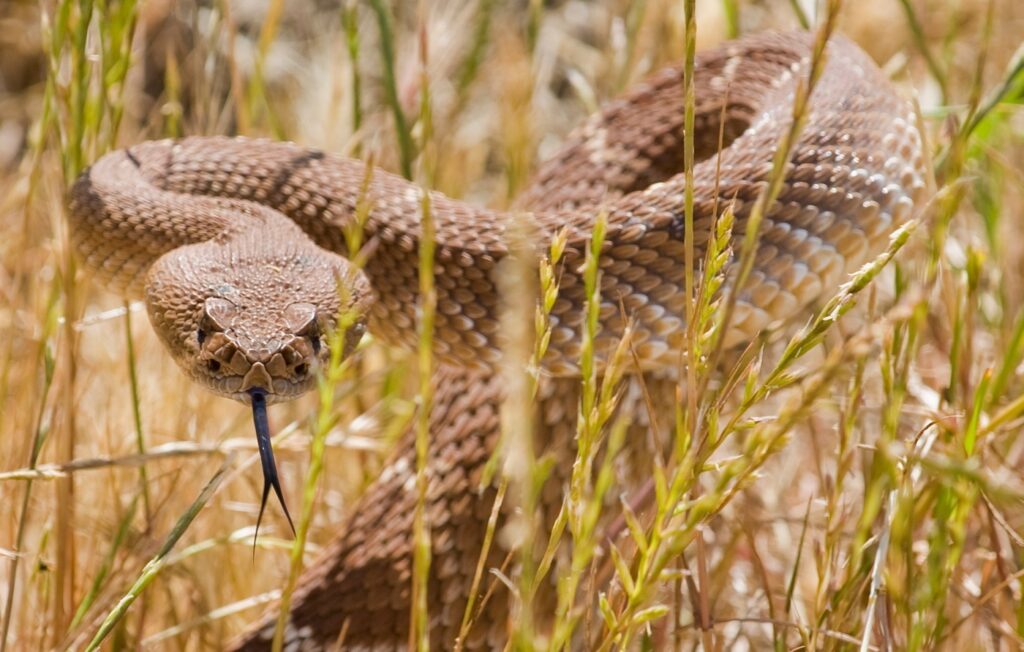
Looking to venture into the outdoors to enjoy the warming Southern California spring? Experts advise hikers to avoid situations that could lead to falls, educate themselves on man-made hazards like off-road vehicles; and to be aware of natural dangers including poisonous plants, rattlesnakes, ticks, black bears and diseased birds and rabbits.
High on the list of natural hazards are rattlesnakes — with their poisonous venom a danger to both hikers and any dogs tagging along. After completing their dormant winter periods, the snakes now spend time in the warm sunlight basking or hunting for food, said Cathy Stadt, recreation supervisor with the Laguna Niguel Department of Parks and Recreation.
Rattlesnake dangers led to Stadt starting a rattlesnake avoidance program for dog owners in 2019, she said.
The program involves a 20-minute appointment between dog owners and an instructor in which their dogs are familiarized with the smells and sights of an enclosed rattlesnake, Stadt said. The dog will then receive an electric shock in order to give the dog a negative association with rattlesnakes, she said.
“When an untrained dog and a rattlesnake meet, the snake is almost always the winner,” Stadt said. “You can pay $5,000 to treat your animal (after they’re bitten) or $65 for a training session.”
Bites can happen during outdoor events and in areas that commonly have rats, Stadt said. She recommended anyone bitten by a rattlesnake to call 911 and have someone come and retrieve them, if possible, in an attempt to slow the bite victim’s blood flow.
Sickened birds and rabbits
Another hazard are birds that may be suffering from bacterial and parasitic diseases, said Krysta Rogers, senior environmental scientist with the state Department of Fish and Wildlife. Hikers encountering birds that appear to be ill or injured should contact a wildlife rehabilitation center for advice.
To protect themselves in the wild, hikers should keep their distance from wildlife and practice good hygiene like hand-washing.
“If recreating outdoors in areas with large concentrations of wild birds or other wildlife, it may be advisable to wash clothing and disinfect footwear and equipment before traveling to other areas or interacting with domestic birds or pets,” Rogers said.
Hikers also should avoid walking through areas laden with dead rabbits as rabbit populations have been affected by a hemorrhagic disease, said Deanna Clifford, senior wildlife veterinarian with the state Department of Fish and Wildlife.
Bears and cougars
Black bears are common in parts of Southern California, said Alex Heeren, research scientist with the state Department of Fish and Wildlife. However, they are typically afraid of humans and encounters can be dealt with by making yourself look as large as possible and making loud noises, according to the agency.
Similar techniques can be applied to encounters with mountain lions, according to Dana Dierkes, spokeswoman for the Angeles National Forest.
Keeping food and other “smellables” out of the open is recommended to maintaining distance from black bears, Heeren said. Further guidance for preventing and mitigating black bear encounters is available through the Department of Fish and Wildlife’s “Keep Me Wild” program.
Ticks and hazardous plants
Bacteria-laden bites from western black-legged ticks that can cause Lyme disease are also a regular concern in the outdoors locally, Heeren said. Tick bites can be prevented by wearing a long-sleeve shirt, tucking your shirt into your pants and your pants into your shoes or socks, the Department of Fish and Wildlife said.
When traversing either the Cleveland, Angeles or San Bernardino national forests, plant hazards to keep an eye out for include poison oak and poodle-dog bush, said Zachary Behrens, a spokesman with the U.S. Forest Service. Poodle-dog bush is a woody shrub with attractive lavender bell-shaped flowers that can cause severe irritation if touched, according to the Forest Service.
Poodle-dog bush can be common in areas recently impacted by wildfires as well as in heavily-traveled areas like the Pacific Crest Trail, Dierkes said.
Human-caused hazards
While there are a wide variety of natural hazards to be on the lookout for when outdoors, some experts said that the greatest sources of peril in the wild tend to be human-caused.
Behrens said that while he was stationed at the San Bernardino National Forest, he received a call every time someone died or was hurt.
“It’s never an animal or plant,” Behrens said. “It’s always vehicles, skiing, rock climbing, suicide.”
Behrens said that vehicles, both street legal and off-highway ones, tend to be the greatest risks in the wild. He emphasized the importance of off-highway vehicle safety, especially in light of newer technologies, such as side-by-side off-road vehicles, which are characterized as utility-task vehicles with bucket or bench seating and a steering wheel.
Heeren said the most common hazards he encounters in his line of work tend to be people tripping, falling or suffering from heat stroke.
The U.S. Forest Service recommends that hikers pack adequate supplies of water along with water purification tablets, a cell phone, a flashlight, first aid equipment, a map and waterproof matches among other things. Hikers are also encouraged to take their timing into account, have a good knowledge of the area and to make sure to check the weather for the area ahead of time.
Related Articles
DMV hearings on DUI license suspensions violate civil rights, court rules
Seal Beach police hold active shooter drill at McGaugh Elementary
Teenage killer who vanished from Santa Ana halfway house is captured
Embattled DNA expert worked on some of OC’s most high-profile murder cases
Folks who save lives are at chief’s throat at OC Fire Authority
